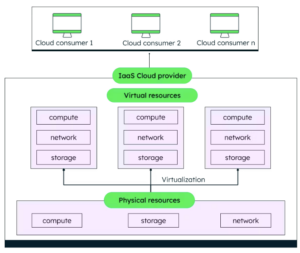In a strategic move to solidify our position as a leader in the FinOps and cloud management market, DoiT has announced the acquisition of LiveDiagrams, a cloud application and architecture mapping solution. The LiveDiagrams platform, designed to simplify and enhance the visualization of cloud environments, will soon be integrated into the DoiT Cloud Intelligence product portfolio as a new feature called Cloud Diagrams. In doing so, DoiT takes a significant step in achieving our vision of providing a holistic multicloud technology platform powered by industry-defining expertise to drive operational excellence.
LiveDiagrams was developed with a specific mission: to address the challenges faced by cloud practitioners and security architects when managing increasingly complex cloud environments. By incorporating LiveDiagrams into its offerings, DoiT continues to expand beyond its traditional FinOps expertise into a more comprehensive cloud management role.
LiveDiagrams: A Closer Look
LiveDiagrams was born out of real-world frustration. Its co-founder, Andrew Lupersolsky, a seasoned InfoSec professional with over two decades of experience, created the tool alongside CTO Yegor Tsynkevich to address the inefficiencies he encountered in his role. As Lupersolskly explained, the shift to cloud computing introduced new challenges for organizations adopting a “you build it, you run it” paradigm. Engineers often worked in silos, prioritizing speed over security and collaboration. This lack of cohesion made it difficult for InfoSec teams to maintain oversight and ensure alignment across departments.
Before the pandemic, resolving these issues often involved hours of in-person whiteboarding sessions. However, with remote work becoming the norm, Andrew identified a gap in the market for a digital solution that could:
- Provide real-time visualization of cloud architectures
- Enable cross-team collaboration
- Help organizations address security, cost efficiency, and operational bottlenecks
Unlike other IT mapping tools, LiveDiagrams was designed to be intuitive and human-centric. Its visualizations are not just aesthetically appealing but are structured to make sense to architects and engineers without extensive manual edits. The platform’s key differentiator lies in its ability to present actionable insights tailored to real-world business needs, rather than serving as a superficial dashboard.
Who Benefits from Cloud Diagrams?
The integration of LiveDiagrams into the DoiT Cloud Intelligence platform as Cloud Diagrams brings immense value to a diverse range of users within an organization:
Security Architects and Engineers
For security professionals, Cloud Diagrams provides a comprehensive view of their cloud environments, highlighting vulnerabilities and enabling proactive measures. By offering a centralized, up-to-date map of cloud infrastructure, it eliminates the guesswork and inefficiencies associated with traditional tools.
Site Reliability Engineers (SREs) and Platform Engineers
These teams benefit from Cloud Diagrams’ ability to streamline troubleshooting and optimize cloud performance. The platform’s detailed visualizations help engineers quickly identify and address issues, reducing downtime and improving system reliability.
Management Teams
Managers who oversee technical teams but lack deep cloud expertise will find value in Cloud Diagrams’ simplified representations. It bridges the gap between technical and non-technical stakeholders, ensuring everyone stays aligned on objectives and progress.
DoiT’s own support and services teams
The introduction of Cloud Diagrams will give customers a greater sense of collaboration and understanding when working with DoiT’s Customer Reliability Engineering team. DoiT’s expert architects and engineers will be able to more easily review the customer environment and identify areas for improvement, all while illustrating exactly where the problem areas lie within the architecture.
By addressing these varied use cases, Cloud Diagrams helps organizations achieve better alignment, reduce costs, and enhance overall cloud security and performance.
Reinforcing DoiT’s Leadership in Cloud Management
The acquisition of LiveDiagrams is a testament to DoiT’s proactive approach to addressing the evolving needs of its customers. As Jake Kaldenbaugh, VP, Corporate Development & Investments at DoiT, explained, the decision to acquire LiveDiagrams was rooted in its ability to accelerate DoiT’s Cloud Intelligence strategy. Cloud Diagrams acceleratesDoiT’s ability to provide a holistic view of cloud environments, empowering organizations to:
- Plan and manage their cloud estates with precision
- Operate efficiently while minimizing costs
- Collaborate across teams to achieve business objectives
Furthermore, this acquisition represents a significant shift for DoiT, moving beyond its traditional role in financial analytics and FinOps. By incorporating operational insights and fostering collaboration, DoiT is redefining what it means to manage cloud environments effectively. As Kaldenbaugh noted, efficiency in the cloud is no longer just about understanding your bill; it’s about ensuring that every aspect of cloud operations aligns with business goals.
Looking Ahead
DoiT’s acquisition of LiveDiagrams marks an exciting chapter in our growth story. With Cloud Diagrams now part of the DoiT Cloud Intelligence portfolio, we’re well-positioned to address the increasing complexity and sprawl of modern cloud environments. This move is just one step in a broader strategy to expand DoiT’s capabilities and cement our status as a leader in cloud management and FinOps.
While specific details about future acquisitions remain under wraps, DoiT’s forward-thinking approach ensures we will continue to identify and address emerging challenges in the cloud space. By leveraging automation, integrating advanced analytics, and fostering innovation, DoiT is set to remain at the forefront of the industry.
As organizations navigate the complexities of cloud computing, DoiT’s technology and expertise will be indispensable in helping them achieve their goals efficiently and effectively. Stay tuned for more updates as we continue to transform the cloud management landscape.


6 Responses
Very useful guide.
The link to calculate the optimal amount of slots doesn’t work (“BQ SE max configuration.sql”), can you fix it please?
Not sure which link you are referring to…
The link is fixed.
ec2 instance connect appears to be locked down to SSH and RDP protocols (ports 22 and 3389 only), meaning you can’t use it for databases in the way this post suggests. You still need to ssh to some instance then connect to the DB from there – the advantage is you don’t need to expose that ec2 instance publicly.
If you go through the above guide, you’ll just get the following error:
awscli.customizations.ec2instanceconnect.websocket – ERROR – {“ErrorCode”:”InvalidParameter”,”Message”:”The specified RemotePort is not valid. Specify either 22 or 3389 as the RemotePort and retry your request.”}
did you actually try the above out successfully?
also discussed here: https://repost.aws/questions/QU_h42-ck0R-alITadXrrXSQ/rds-configuration
ec2 instance connect appears to be locked down to SSH and RDP protocols (ports 22 and 3389 only), meaning you can’t use it for databases in the way this post suggests. You still need to ssh to some instance then connect to the DB from there. If you go through the above guide, you’ll just get the following error: awscli.customizations.ec2instanceconnect.websocket – ERROR – {“ErrorCode”:”InvalidParameter”,”Message”:”The specified RemotePort is not valid. Specify either 22 or 3389 as the RemotePort and retry your request.”} did you actually try the above out successfully? also discussed here: https://repost.aws/questions/QU_h42-ck0R-alITadXrrXSQ/rds-configuration
Always curious to learn more about Cloud data